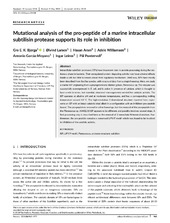| dc.contributor.author | Bjerga, Gro Elin Kjæreng | |
| dc.contributor.author | Larsen, Øivind | |
| dc.contributor.author | Arsin, Hasan | |
| dc.contributor.author | Williamson, Adele Kim | |
| dc.contributor.author | Garcia-Moyano, Antonio | |
| dc.contributor.author | Leiros, Ingar | |
| dc.contributor.author | Puntervoll, Pål | |
| dc.date.accessioned | 2019-05-28T08:18:59Z | |
| dc.date.available | 2019-05-28T08:18:59Z | |
| dc.date.issued | 2018-09 | |
| dc.Published | Bjerga GE, Larsen Ø, Arsin H, Williamson AK, Garcia-Moyano A, Leiros I, Puntervoll P. Mutational analysis of the pro-peptide of a marine intracellular subtilisin protease supports its role in inhibition. Proteins: Structure, Function, and Bioinformatics. 2018;86(9):965-977 | eng |
| dc.identifier.issn | 0887-3585 | en_US |
| dc.identifier.issn | 1097-0134 | en_US |
| dc.identifier.uri | http://hdl.handle.net/1956/19750 | |
| dc.description.abstract | Intracellular subtilisin proteases (ISPs) have important roles in protein processing during the stationary phase in bacteria. Their unregulated protein degrading activity may have adverse effects inside a cell, but little is known about their regulatory mechanism. Until now, ISPs have mostly been described from Bacillus species, with structural data from a single homolog. Here, we study a marine ISP originating from a phylogenetically distinct genus, Planococcus sp. The enzyme was successfully overexpressed in E. coli, and is active in presence of calcium, which is thought to have a role in minor, but essential, structural rearrangements needed for catalytic activity. The ISP operates at alkaline pH and at moderate temperatures, and has a corresponding melting temperature around 60 °C. The high‐resolution 3‐dimensional structure reported here, represents an ISP with an intact catalytic triad albeit in a configuration with an inhibitory pro‐peptide bound. The pro‐peptide is removed in other homologs, but the removal of the pro‐peptide from the Planococcus sp. AW02J18 ISP appears to be different, and possibly involves several steps. A first processing step is described here as the removal of 2 immediate N‐terminal residues. Furthermore, the pro‐peptide contains a conserved LIPY/F‐motif, which was found to be involved in inhibition of the catalytic activity. | en_US |
| dc.language.iso | eng | eng |
| dc.publisher | Wiley | en_US |
| dc.rights | Attribution CC BY | eng |
| dc.rights.uri | http://creativecommons.org/licenses/by/4.0/ | eng |
| dc.title | Mutational analysis of the pro-peptide of a marine intracellular subtilisin protease supports its role in inhibition | en_US |
| dc.type | Peer reviewed | |
| dc.type | Journal article | |
| dc.date.updated | 2019-01-04T14:39:14Z | |
| dc.description.version | publishedVersion | en_US |
| dc.rights.holder | Copyright 2018 The Author(s) | en_US |
| dc.identifier.doi | https://doi.org/10.1002/prot.25528 | |
| dc.identifier.cristin | 1610186 | |
| dc.source.journal | Proteins: Structure, Function, and Bioinformatics | |
| dc.relation.project | Norges forskningsråd: 221568 | |
| dc.identifier.citation | Proteins: Structure, Function, and Bioinformatics. 2018, 86 (9), 965-977. | |

